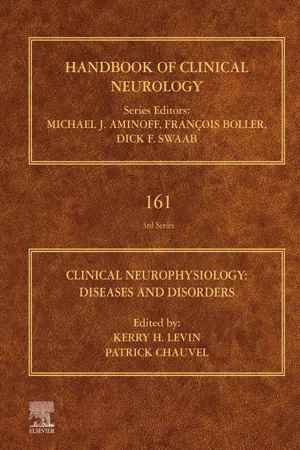Chapter 1
Generalized epilepsies
Renzo Guerrini
*;
Carla Marini;
Carmen Barba
Neuroscience Department, Children's Hospital A. Meyer-University of Florence, Florence, Italy
* Correspondence to: Renzo Guerrini, Neuroscience Department, Children's Hospital A. Meyer-University of Florence, viale Pieraccini 24, 50139, Florence, Italy. Tel: + 39-0555662573 email address: [email protected]Abstract
Idiopathic generalized epilepsies (IGE) are characterized by normal background EEG activity and generalized interictal spike-and-wave discharges in the absence of any evidence of brain lesion. Absence epilepsies are the prototypes of IGEs. In childhood and juvenile absence epilepsies, by definition, all patients manifest absence seizures associated with an EEG pattern of generalized spike-wave (GSW) discharges. In juvenile myoclonic epilepsy, myoclonic jerks, usually affecting shoulders and arms bilaterally and appearing upon awakening, are the most characteristic clinical feature. Myoclonic jerks are accompanied on the EEG by generalized spike/polyspike-and-wave (GSW, GPWS) complexes at 3.5–6 Hz. Idiopathic generalized epilepsy with generalized tonic–clonic seizures only is a broad and nonspecific category including all patients with generalized tonic–clonic seizures and an interictal EEG pattern of GSW discharges. Despite the strong heritability and the recent advances in genetic technology, the genetic basis of IGEs remains largely elusive and only in a small minority of patients with classic IGE phenotypes is a monogenic cause identified. Early myoclonic encephalopathy (EME), early infantile encephalopathy with suppression bursts, West syndrome, and Lennox–Gastaut syndrome, once classified among the generalized epilepsies, are now considered to be epileptic encephalopathies. Among them, only Lennox–Gastaut syndrome is characterized by prominent generalized clinical and EEG features.
Keywords
Absences; Generalized tonic–clonic seizures; Genetic epilepsies; Spike-and-wave; Spike-and-wave discharges; Myoclonic epilepsy; Photosensitivity
The International League Against Epilepsy (ILAE) classification of epilepsies and epileptic syndromes (ILAE, 1989) identified syndromes as groups of signs and symptoms that customarily occur in association, in a clinical context that included not just seizure types, but also the clinical background, neurophysiologic and neuroimaging findings, and, often, outcome. According to ictal symptoms, epilepsies were classified as generalized and partial (or focal). Generalized epilepsies were defined as characterized by generalized seizures, bilateral motor manifestations, and generalized interictal and ictal EEG discharges. From an etiological point of view, generalized epilepsies were subdivided into idiopathic, cryptogenetic, and symptomatic. Idiopathic epilepsies were characterized by normal background EEG activity and interictal generalized spike-and-wave (GSW) discharges in the absence of any brain lesion. The term cryptogenic was used to define syndromes that were presumed to be symptomatic, whose etiology was unknown. Symptomatic epilepsies were considered the expression of a focal or diffuse brain abnormality as demonstrated by clinical history, structural neuroimaging, EEG findings, or biological tests. This etiological classification has been modified through the 2001 (Engel, 2001), 2006 (Engel, 2006), 2010 (Berg et al., 2010), and 2017 (Scheffer et al., 2017) ILAE reports. In particular, the term cryptogenetic has been discouraged in favor of the wording “probably symptomatic” (Engel, 2006), while the concept of symptomatic epilepsies has been stratified into several etiological categories: metabolic, structural, infectious, genetic, immune, and unknown (Berg et al., 2010; Scheffer et al., 2017). An additional new concept has identified most idiopathic generalized epilepsy syndromes as “genetic generalized epilepsies (GGEs)” (Berg et al., 2010), in order to distinguish them from the “secondary” lesional generalized epilepsies, such as Lennox–Gastaut syndrome. An example is represented by the familial epilepsy syndrome initially defined as “generalized epilepsy with febrile seizures plus (GEFS +)” (Scheffer and Berkovic, 1997). GEFS + is a typically inherited disorder with autosomal dominance and variable penetrance. About one-third of affected family members only have febrile seizures, about one-third develop a few afebrile generalized tonic–clonic seizures in childhood with remission in adolescence, and the remaining one-third may have generalized epilepsies, including childhood absence and myoclonic astatic epilepsy (Camfield and Camfield, 2015). Recently, patients with focal epilepsy have also been described (Myers et al., 2017). Genetic studies of GEFS + families found SCN1A gene mutations in some. Owing to the possible occurrence of focal seizures and the genetic etiology, the wording “generalized epilepsy with febrile seizures plus” has been changed to “genetic epilepsy with febrile seizures plus” (still GEFS +) (Zhang et al., 2017).
However, in 2017, the ILAE Task Force for Classification and Terminology (Scheffer et al., 2017) considered that the term idiopathic generalized epilepsy (IGE) could still be acceptable for four well-characterized epilepsy syndromes: childhood absence epilepsy (CAE), juvenile absence epilepsy (JAE), juvenile myoclonic epilepsy (JME), and IGE with generalized tonic–clonic seizures only (IGE-TCS).
Absence Epilepsies
Absence epilepsies are the prototypes of IGEs. Childhood and juvenile forms are recognized in which, by definition, all patients manifest absence seizures associated with an EEG pattern of GSW discharges (ILAE, 1989).
Before the ILAE classification introduced the age-related partition of absence seizure syndromes into childhood and juvenile forms, this distinction was only used in German publications (Janz and Christian, 1957; Doose et al., 1965). Doose, Janz, and colleagues had clearly recognized that absence epilepsy had a first peak of age of onset at 6–7 years, corresponding to the typical CAE, while a second peak was near age 12 years, corresponding to the juvenile form. Thus, JAE typically begins during puberty, between age 10 and 17 years (Wolf, 1992; Obeid, 1994).
Childhood absence epilepsy
Childhood absence epilepsy has an estimated incidence of 6.3–8/100,000 in children aged 0–15 years (Loiseau, 1992); it accounts for 2%–12% of patients with epilepsy (Berg et al., 2000) and is definitely age related. Typical absence seizures are sudden and brief, lasting 5–15 s, with periods of loss of awareness with interruption of ongoing activities, followed by immediate and complete recovery (Fig. 1.1A). Although absences were initially described as staring spells, a minority of patients have simple absences with unresponsiveness and interruption of ongoing activity (Penry et al., 1975). Most children exhibit complex absences, with additional clinical phenomena such as automatisms (Fig. 1.1B) with tonic, atonic, or autonomic components (Penry et al., 1975; Holmes et al., 1987). Absences are very frequent, occurring up to 100 times per day. They occur spontaneously but are also influenced by various factors, espec...
